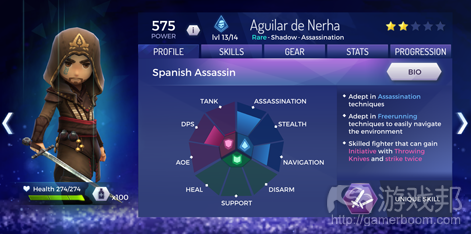从产品体验的角度聊《刺客信条:燎原》是如何盈利的
从产品体验的角度聊《刺客信条:燎原》是如何盈利的
原作者:Jon Jordan 译者:Vivian Xue
欢迎来到The In-App Purchase Inspector,我们站在消费者的角度观察和分析F2P游戏的盈利模式。
每一期我们都会评估一款游戏的内购设计,它是如何同游戏的核心玩法以及meta游戏体验相结合的。
本期我们观察的游戏是育碧的手游《刺客信条:燎原》(Assassin’s Creed: Rebellion)。
走近兄弟会
鉴于最近某款深受喜爱的PC/主机游戏移植为手游引发了人们的争议(指暴雪嘉年华上公布手游版《暗黑破坏神》遭到玩家抵制,游戏邦注),我觉得有必要先指出一点,《刺客信条:燎原》与《刺客信条》系列——复杂的3D潜行刺杀,以及愈发宏大的开放的世界游戏相比,有着本质上的不同。
它是《刺客信条》系列中的第一款F2P手游,不仅增加了RPG元素,还包含一个核心的基地建设机制。从画面上看,它还是一款Q版的2D游戏,游戏中的刺杀不需要玩家亲自动手操作。
鉴于此,这款游戏和主机版的《刺客信条》的关联性不太大。你将在游戏里解锁那些熟悉的刺客们,包括著名的艾吉奥、阿圭勒和邵云。
除此之外,这部游戏的背景设定在文艺复兴时期的西班牙,玩家将召集刺客们对抗圣殿骑士团——可以说《刺客信条:燎原》拥有自己独特的剧情。
更多的奖励、更快的速度
有趣的是,一些重要的游戏元素是在长达17个月的测试发行过程中诞生的,这一测试发行过程见证了Ubisoft和Behaviour Interactive(《辐射:避难所》的开发商)共同创造出了一个比原始测试版本更有深度的meta游戏。
其中一个值得关注的功能是加速模式(rush mode),玩家能够从已完成的三星任务中立即获得奖励。另一个是自动模式,一旦玩家选择了三人刺客阵容,游戏的AI将控制它们进行所有的移动和回合战斗。
在亚洲F2P手游的推广下,这两种功能已经成为许多手游的标配,但在那些认为玩法高于meta的人眼里仍然是可耻的功能。
纵观各版本的《刺客信条》,这款手游在试发行之初不具备这些功能也没什么好奇怪的。对于Ubisoft和Behaviour来说,他们最终接纳了这些F2P手游的必备功能,目的在于获得长期的成功。
训练你的刺客
尽管加入了这些功能,但《刺客的信条:燎原》绝不是一款剥削玩家的游戏。游戏不对玩家做强硬推销,也不存在收费墙;玩家通过玩游戏同样可以获得丰厚的奖励,并且游戏总是为玩家提供许多的任务。
当然,游戏的核心是解锁新刺客并提升他们的等级。
《刺客信条:燎原》提供了46个人物选择,每个人物的属性值不同,大致可以分成暗影、专家和运行者三种类型,在基地建设中他们发挥的技艺和研究能力也不一样。
同时根据稀有度刺客还被划分成常见、稀有、史诗和传奇四种类型,玩家通过获取战利品宝箱(在游戏里叫做DNA方盒)收集随机发放的DNA碎片来解锁和升级刺客。
显然,玩家想要快速变强必须氪金。120个DNA碎片需要1800积分 (游戏中的硬通货,每100个积分大约需要花费1美元)。
游戏微交易还提供了一些更直接的礼包,玩家购买后可以立刻招募或增强特定的刺客,并获得一些其它的物资。
基地建设
除了升级刺客外,打造装备在游戏中同样重要,玩家需要消耗另外一套物资来合成装备。总的来说,基地建设是一切的支撑。
基地中的每个房间拥有各自的资源经济和升级系统,可以制造武器、升级角色、收集资源,还可以提升体力,体力关系到玩家在任务和特殊活动中的表现。
简单地说,《刺客的信条:燎原》中有许多相互关联的层次,新玩家上手不太容易。
游戏设计了每日目标列表,帮助玩家理清他们需要做的事项,尽管如此,如何留住这些粉丝毫无疑问是一大挑战。
不过有趣的是,为了提升留存和盈利,我们或许将很快看到这款依赖限时活动的单人游戏加入公会或联盟这样功能。
然而,《刺客信条:燎原》基本遵循了当前最成功的F2P手游的meta设计和盈利模式。除了一些有趣的每月活动外,它并没有创造太多新鲜的东西。
鉴于此,除非你是《刺客信条》系列的粉丝并且坚决地反对暴雪手游化的想法,那么这款手游确实没什么可抱怨的。
同时,那些喜爱F2P手游的人将从中感受到《刺客信条》的魅力及其精良的制作。
本文由游戏邦编译,转载请注明来源,或咨询微信zhengjintiao
Welcome to The In-App Purchase Inspector – our regular look at free-to-play mobile game monetisation from the consumer’s perspective.
In each instalment, we consider how well a developer has designed its in-app purchase retailing to work alongside the overall gameplay and metagame experience.
This time we’re looking at Ubisoft’s Assassin’s Creed: Rebellion.
Enter the Brotherhood
Given the controversy currently surrounding the transition of much-loved PC/console franchises to mobile, it’s worth pointing out from the get-go that Assassin’s Creed: Rebellion is a very different game compared to the complex 3D stealth parkour – and increasing open-world expansiveness – of its core franchise.
The first Assassin’s Creed game built from-the-ground-up as a free-to-play mobile experience, Rebellion doesn’t only add role-playing elements to its action but contains a core base-building foundation too. Graphically, it’s also a Chibi-styled 2D game with a strongly autoplay-focused metagame.
Given that approach, the link to the console Assassin’s Creed games could be viewed as fairly lightweight. You unlock signature assassins from those games with characters including the likes of Ezio, Aguilar and Shao Jun highlighted.
Aside from this – and the nominal setting, which sees you battling the Knights Templar in Renaissance Spain – Rebellion is very much its own experience.
More rewards, quicker
Interestingly, some significant elements have resulted from the game’s long – 17 month – soft launch, which has seen Ubisoft and developer Behaviour Interactive (of Fallout Shelter fame) create a much deeper metagame than that which was originally tested.
Notable in this respect is the addition of the rush mode, which enables players to gain instant rewards from missions already three-star completed, and the auto-play mode, whereby once the player has selected their three-person squad, the game’s AI controls all the movement and turn-based battles through to victory or defeat.
Popularised by Asian F2P mobile games developers, both elements are now standard in many mobile gaming genres but still retain stigma in the eyes of those who prioritise gameplay over metagame.
Given the history of the Assassin’s Creed games, it was perhaps no surprise then that these elements weren’t included at the start of the soft launch. So it’s to Ubisoft and Behaviour’s credit they eventually accepted these are now a necessity for any F2P mobile game that hopes to generate long-term success.
Sharpen your assassins
Despite their inclusion, Assassin’s Creed: Rebellion in no way feels like an exploitative game with respect to monetisation, however. There’s no hard sell or egregious content gating; players are well rewarded for just playing the game and there’s always plenty to do and tinker with.
Of course, the core progression element is unlocking new assassins and levelling up the ones you have.
Rebellion launches with 46 characters, each of which has different stats broadly split into stealth, support and tank combat characteristics, as well as crafting and research abilities when it comes to base-building activities.
There’s also the usual demarcation in terms of common, rare, epic and legendary characters, which feeds into a gacha loot box system (here called DNA Cubes), whereby players need to collect the random DNA fragments each cube drops to unlock and then upgrade their assassins.
Low-quality cubes are gifted every four hours, while better quality cubes become available the more you play.
Obviously, players who want to progress quicker will have to spend money, with the default option being 120 DNA fragments for 1,800 Credits (the game’s hard currency, which roughly converts to 100 credits per $1).
There are more direct bundle deals too, whereby players can instantly recruit and power up specific assassins, gaining more general resources into the bargain.
Start with the base
Another layer for the assassins is provided via their equippable gear, which players have to craft using a new set of resources. And, more generally, underpinning everything is base-building.
The base has its own resource economy and levelling system for individual rooms, which are required respectively for item crafting, character progression and resource gathering, including the energy system which gates how quickly players can power through the missions and special events.
Simply put then, Assassin’s Creed: Rebellion has a lot of interlinked layers, which makes it a rather daunting experience for new players.
Helping them make sense of what they should be doing is down to the daily objectives list, but even so, the game’s first challenge will likely be retaining the large numbers of users its release will no doubt generate.
It will also be interesting to see how quickly additional retention and monetisation features such as guilds or alliances will be added to a game that launches as a single-player experience and relies on time-limited events to provide additional engagement.
More generally, however, the metagame design and hence the monetisation of Assassin’s Creed: Rebellion follows current best practice in terms of F2P mobile game trends. Aside from some interesting monthly subscription deals, it’s not really doing much new.
And in that respect, unless you’re an Assassin’s Creed fan with the hard-nosed attitude of a Diablo player at BlizzCon, there’s little to complain about in Assassin’s Creed: Rebellion.
Meanwhile, those inclined towards F2P mobile gaming will enjoy both the brand’s cache and the title’s polished implementation.(source:PocketGamer.biz )








































 闽公网安备35020302001549号
闽公网安备35020302001549号